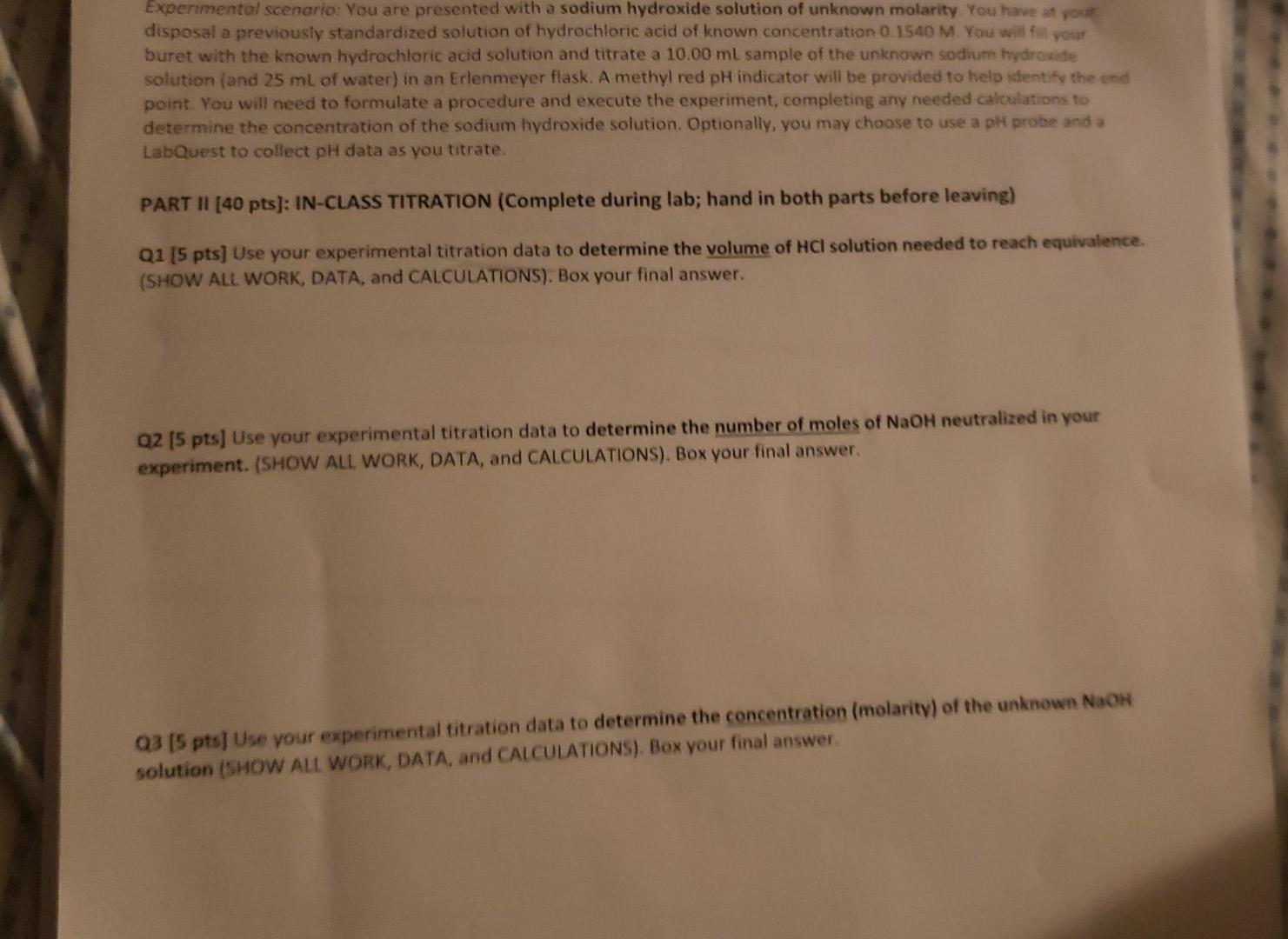Answered step by step
Verified Expert Solution
Question
1 Approved Answer
Experimental scenario: You are presented with a sodium hydroxide solution of unknown molarity. You have at your disposal a previously standardized solution of hydrochloric acid

Experimental scenario: You are presented with a sodium hydroxide solution of unknown molarity. You have at your disposal a previously standardized solution of hydrochloric acid of known concentration 0.1540 M. You will fill your buret with the known hydrochloric acid solution and titrate a 10.00 ml sample of the unknown sodium hydroxide solution (and 25 ml of water) in an Erlenmeyer flask. A methyl red pH indicator will be provided to help identify the end point. You will need to formulate a procedure and execute the experiment, completing any needed calculations to determine the concentration of the sodium hydroxide solution. Optionally, you may choose to use a pH probe and a LabQuest to collect pH data as you titrate. PART II [40 pts]: IN-CLASS TITRATION (Complete during lab; hand in both parts before leaving) Q1 [5 pts] Use your experimental titration data to determine the volume of HCI solution needed to reach equivalence. (SHOW ALL WORK, DATA, and CALCULATIONS). Box your final answer. Q2 [5 pts] Use your experimental titration data to determine the number of moles of NaOH neutralized in your experiment. (SHOW ALL WORK, DATA, and CALCULATIONS). Box your final answer. Q3 [5 pts] Use your experimental titration data to determine the concentration (molarity) of the unknown NaOH solution (SHOW ALL WORK, DATA, and CALCULATIONS). Box your final answer. Experimental scenario: You are presented with a sodium hydroxide solution of unknown molarity. You have at your disposal a previously standardized solution of hydrochloric acid of known concentration 0.1540 M. You will fill your buret with the known hydrochloric acid solution and titrate a 10.00 ml sample of the unknown sodium hydroxide solution (and 25 ml of water) in an Erlenmeyer flask. A methyl red pH indicator will be provided to help identify the end point. You will need to formulate a procedure and execute the experiment, completing any needed calculations to determine the concentration of the sodium hydroxide solution. Optionally, you may choose to use a pH probe and a LabQuest to collect pH data as you titrate. PART II [40 pts]: IN-CLASS TITRATION (Complete during lab; hand in both parts before leaving) Q1 [5 pts] Use your experimental titration data to determine the volume of HCI solution needed to reach equivalence. (SHOW ALL WORK, DATA, and CALCULATIONS). Box your final answer. Q2 [5 pts] Use your experimental titration data to determine the number of moles of NaOH neutralized in your experiment. (SHOW ALL WORK, DATA, and CALCULATIONS). Box your final answer. Q3 [5 pts] Use your experimental titration data to determine the concentration (molarity) of the unknown NaOH solution (SHOW ALL WORK, DATA, and CALCULATIONS). Box your final
Step by Step Solution
There are 3 Steps involved in it
Step: 1

Get Instant Access to Expert-Tailored Solutions
See step-by-step solutions with expert insights and AI powered tools for academic success
Step: 2

Step: 3

Ace Your Homework with AI
Get the answers you need in no time with our AI-driven, step-by-step assistance
Get Started


